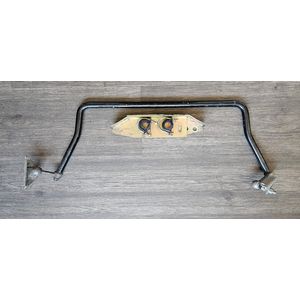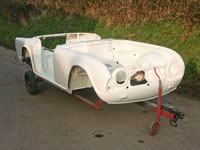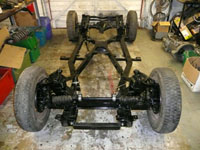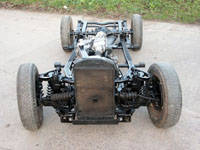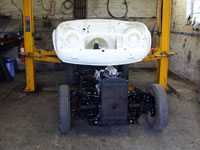The TR4 Police Car - Neil reports on restoring the last remaining example
Published: 21 Jan 2009 updated: 05 Feb 2019
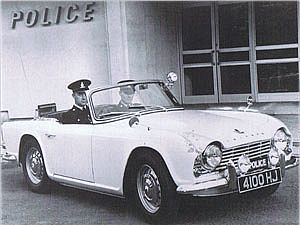
 |
| 4100HJ during its years of service to Southend On Sea Police Force |
Revington TR have had the good fortune over the years to have been involved in the restoration of some very special cars: the Zoom Prototype (Partially completed), TR5 Prototype and 3 of the VC TR4 Rally cars to name but a few. The current project of interest is the only known surviving TR Police Car. The car served with the Southend on Sea police force as a high-speed pursuit car before being sold off into private hands.
Ernie Cole in Bristol bought the car in the late 70's and ran it for a while without knowing its history, later Ernie spotted a photo of his car in a book and all was revealed. Ernie with his wife Debbie ran the car for a number of years but the car became somewhat ragged, so they decided to sell. By then Sue and I had become good friends with Ernie and Debbie and couldn't live with the idea of the car leaving the area so I foolishly decided to buy it (I had plenty of cars already that needed restoring so another was not exactly a good idea, but, boys and toys hey?).
The car languished in the back of our barn for a few years and then early in the new millennium I felt the time was right to rebuild the car. The interesting part of a rebuild such as this is two fold, discovering the little differences on the car that make it special and researching the history to be able to fill in the gaps.
|
The body shell was tackled first, this was mostly original with mountings for the Winkworth Bell and the PYE radio, but during a previous rebuild the B-Posts had been changed for TR5/6 parts. I can just imagine the owner at the time standing at the counter of his local Leyland dealer 'Can I have a pair of B posts for a 1962 TR4 please'. 'Sorry mate can't supply those but I have these TR6 ones that are the same'. The hapless owner would not have spotted the difference until he came to hang the doors, only to find all the catches are different. Hence the car had TR5/6 doors to match the B-Posts and get over the mistake.
|
These minor errors were corrected along with the fitment of new floors and sills, which is a must for all TR4-6 shell rebuilds. Once repainted white, the body was tucked away awaiting yours truly to find the time to build the chassis up. This was supposed to happen over Christmas 2007/8 when time was set aside to fit the suspension, engine, gearbox and axle and drop the body onto the chassis; sounds easy doesn't it? Well, I got as far as assembling the axle and front suspension and that is how it stayed until Christmas 2008/9 when I finally got the chassis work finished and the body fitted. Better late than never! So that is where we are today. As the car is now one major lump it should be relatively straightforward now to refit all the myriad of small bits that make up a complete car.
So what makes a TR4 Police Car Special? Well, as you would expect the Police force bought a standard TR4 in white, with a soft top. It would then go to the workshops of the force it was to serve to have all the extras fitted. The equipment list is quite extensive: Front illuminated Police sign, Winkworth bell, 2 spot lamps mounted on the front bumper, hand operated spot lamp on the left hand windscreen pillar, Rear 'STOP' sign mounted on the boot lid, two tone 'Wind Tone' horns, PYE Communication radio with hand held mike and to power all this equipment an alternator. On the matter of replacing specific Police equipment the Police Federation Historic Vehicle Club have been most helpful and have offered to supply front and rear signals and the PYE radio. The Winkworth Bell on the other hand I already have. Needless to say, these would have been removed when the car was sold into private hands.
|
|
Additional to the above there are two other discreet modifications, the first being an intersecting brace where the handbrake cable enters the chassis support, perhaps some burley officer managed to bend the bracket, so the workshops decided to beef it up? Who knows but its there! The second being strengtheners welded to the chassis. These I initially thought to be for seatbelts but during the fitment of the body it became obvious they were there so that the seats could be bolted to the chassis rather than just to the floor, which was standard. This was further reinforced (excuse the pun) when an email was received from a constable who once rode in the car at the time of its service. Constable Tony Hall has an interesting story to tell, so as a short diversion here it is:
"I'm afraid my memories are somewhat sketchy. I was a young constable and only ever got to be driven as 'observer' in this unique (so far as I know) vehicle a couple of times.
Part of our role in this vehicle was to act as 'Courtesy Cops' by stopping drivers who we thought were driving particularly well or who showed particular courtesy to other drivers and commend them for their skill or courtesy. We had white nylon sleeves over our tunics to compliment this when we signalled to drivers to pull in. I can't imagine any such thing going on in today's traffic and always thought this a double-edged sword as I wondered whether drivers might be irritated to have their journey delayed so, but no one ever complained. <
Two incidents do come to mind, one of which may answer one of your questions. The first is rather comical. We were driving, top down, along a wide urban dual carriageway, Thorpe Hall Avenue, towards the sea front, when I notice a seagull ahead fly across from left to right and discharge its load from about 30 feet up. This splattered across the windscreen right in front of my face. Had we been travelling a fraction faster I would have received the full force of this bomb!
The second is more serious and may answer your question about seat belts. I cannot recall ever wearing these, and I don't think they were fitted, because I recall that when we were doing any fast cornering I had to hang on to the seat squab to keep from ending up in the driver's lap. On one occasion this actually happened. We were driving along the sea front and were directed to an incident and went off at high speed turning left from the sea front into Lifstan Way. I was hanging on in the usual manner but during this corner found myself suddenly catapulted sideways against the driver - the left hand seat outer runner securing bolts had pulled through the floor pan!
I have to add that I was then a mere waif of 12 stone and we fortunately came out without mishap, though the TR4 needed some reinforcing work on the seat mountings."
The story such as the one above is the very reason why it is important that these historic cars are preserved. This doesn't just apply to unique historic vehicles, I'm sure many of you car enthusiasts out there have your own personal stories and memories associated with your own pride and joy, as do I. If these cars are left to rot, those memories will fade, it's restoring those memories as well as the car that excites me about these projects. I hope to have the car out and about summer 2009, but given the amount of time it took to get the body onto the chassis, I suggest you don't hold your breath!
Neil Revington

